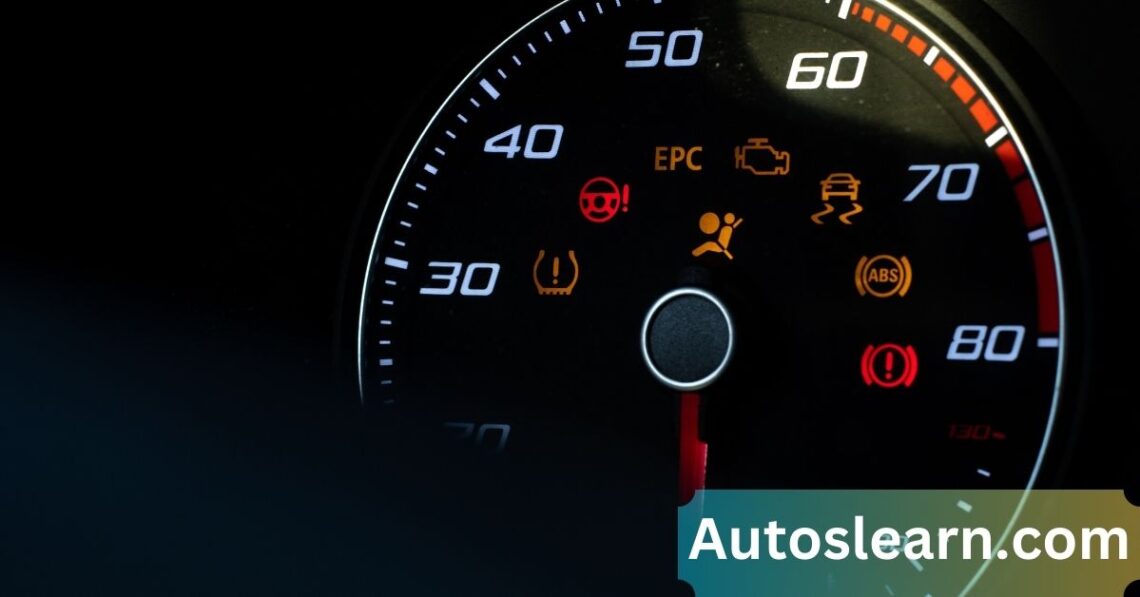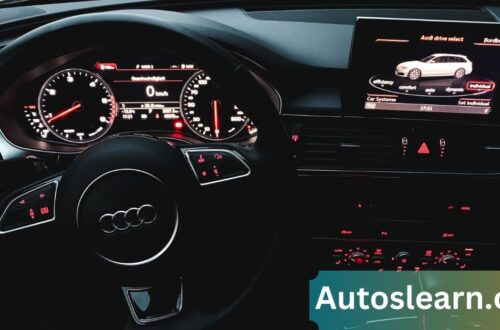The EPC light on an Audi stands for Electronic Power Control. A warning light on the dashboard tells you something is wrong with the car’s electronic control system. In simple terms, EPC is part of the engine management system. It watches over the parts that help your car accelerate and run smoothly.
When the EPC light comes on, the car’s computer has found a problem with these parts. It does not mean the vehicle will instantly stop, but you must pay attention and find the cause.
What Does the EPC System Do?
The EPC system in an Audi controls and monitors many engine parts, especially those involved in acceleration. For example, it keeps track of the throttle body (a valve that lets air into the engine) and the accelerator pedal. It also monitors the mass airflow sensor (which measures air intake) and the throttle position sensor (which monitors how far you push the gas pedal).
In addition, the EPC system can check parts of the braking and cruise control systems. These pieces work together to ensure the engine gets the right air and fuel and that the car can speed up safely.
The EPC helps the car run smoothly and safely when everything is working correctly. If the system finds a problem, it lights up the EPC warning light on the dash. For example, if a sensor is giving wrong information or a throttle valve is stuck, the light will tell you. It’s a way for the car to say, “Check me—something needs attention.”
Components Monitored by the EPC:
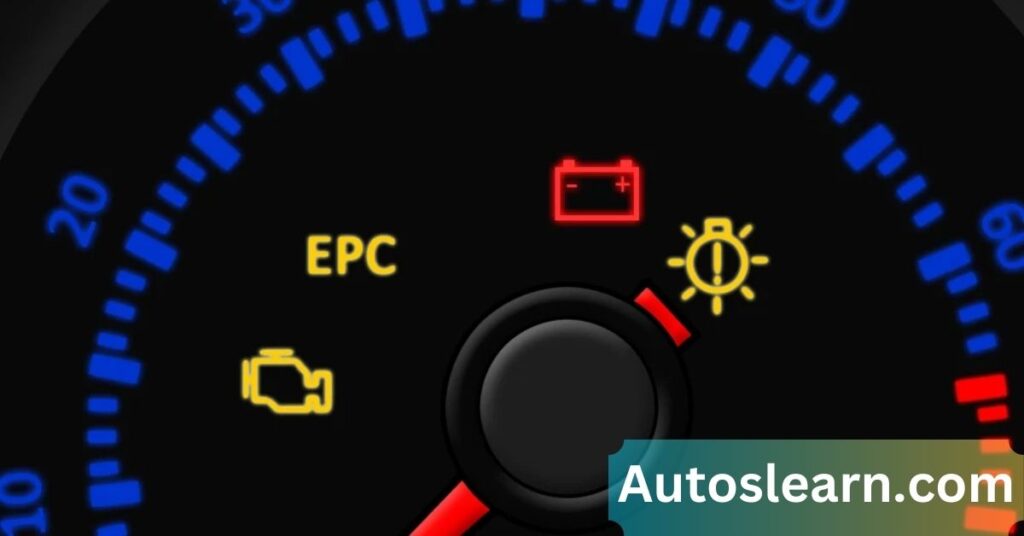
The EPC light can signal trouble in many parts of the car’s electronic engine control system. Typical components that the EPC system watches include:
1. Throttle Body and Pedal:
These control how much air enters the engine when you press the accelerator. The EPC light can turn on if the throttle body is dirty or the pedal sensor is bad.
2. Engine Sensors:
The EPC monitors sensors like the mass air flow (MAF) sensor, crankshaft position sensor, and oxygen sensor. If any of these fail or give wrong readings, engine performance suffers, and the EPC light may come on.
3. Accelerator Pedal Sensor:
Some Audis use a sensor on the gas pedal. If this sensor fails, the car may not know how much you press the pedal, triggering the EPC light.
4. Brake Light Switch:
The switch under the brake pedal tells the computer when the brake is pressed. If the switch is broken, it can cause strange signals (and turn off your brake lights and cruise control), triggering the EPC warning.
5. Cruise Control System:
Because cruise control uses the throttle and brake, a fault in the cruise control can cause the EPC light to malfunction. For example, if cruise control is stuck on or unable to disengage, it may trigger EPC.
6. Wiring and Electrical:
Any broken or loose wires that carry signals between these parts and the engine computer can also cause the EPC light to come on.
7. Electronic Control Unit (ECU):
The engine’s computer (ECU) manages all these parts. If there is an error or glitch, the ECU can set off the EPC light.
8. Engine/Braking System:
Occasionally, issues with ignition coils, spark plugs, or even the anti-lock brake (ABS) system can be an EPC warning.
Each part helps the car accelerate, brake, or maintain a stable engine speed. When any part of this system works incorrectly, the EPC light warns you of a problem that needs fixing.
Common Reasons the EPC Light Turns On:
For several reasons, you might see the EPC light turn on in an Audi. Here are some of the most frequent causes, explained plainly:
1. Dirty or Faulty Throttle Body:
The throttle body can collect dirt over time or become mechanically stuck. This valve controls airflow into the engine. If it’s clogged or not moving right, the engine can’t get the correct air mixture and will set off the EPC light.
2. Bad Engine Sensors:
Sensors like the mass airflow or throttle position sensors can fail. For example, if the mass airflow sensor that measures incoming air malfunctions, the computer can’t balance fuel and air correctly. This confusion often lights the EPC sign.
3. Crankshaft or Camshaft Sensors:
The computer uses signals from these sensors to time engine pulses. If these fail, the engine runs poorly or not at all, triggering EPC.
4. Brake Light Switch Problems:
A broken switch under the brake pedal can cause the computer to think you’re braking when you’re not, or vice versa. This affects cruise control and stability systems and will illuminate the EPC light.
5. Faulty Accelerator Pedal Sensor:
Modern Audis often use a pedal sensor instead of a direct cable. If this sensor is bad, the car won’t know how far you press the gas, which can trigger the EPC light.
6. Cruise Control Malfunction:
If cruise control can’t disengage or has a wiring problem, it interferes with throttle control. A broken cruise control stalk or module may cause the EPC light.
7. Electrical or Wiring Issues:
Loose or corroded electrical connectors and wires can cut off signals. For instance, a loose wire on a throttle sensor can cause intermittent EPC warnings.
8. Ignition Problems:
Faulty spark plugs or ignition coils sometimes register as engine management errors. The car may respond by lighting the EPC instead of (or in addition to) the check engine light.
9. Engine Load or ECU Errors:
If the engine control unit sees conflicting data or the engine is running out of spec, it will trigger EPC. In rare cases, the computer itself could have a fault, setting off the warning.
Every one of these problems influences the engine’s performance. For example, the engine might run too rich or lean if a sensor gives wrong information. The EPC light then tells you something isn’t right. If you see the EPC light, you may also notice symptoms like the engine not accelerating as hard, the car going into a limp mode (limited power), or cruise control stopping. Paying attention to these symptoms can help pinpoint the problem.
What to Do When the EPC Light Comes On:
If the EPC light comes on while driving, take it seriously, but stay calm. The light means your car’s computer detected something wrong, but often, the car will still run. Follow these steps:
1. Safely Observe the Car:
First, watch the car’s behavior. Is the engine underperforming or possibly in limp mode? Are the brakes functioning as expected? Has cruise control been disabled or become unresponsive? These signs can point you toward the root of the issue.
2. Do Not Panic, Slow Down:
The car is likely designed to keep running at a reduced performance (“limp” mode) so you can drive safely. Slow down gently and avoid hard acceleration. The EPC light often comes with a reduction in engine power to protect the engine.
3. Consider Stopping Soon:
Consider pulling over at the next safe spot if the light just popped on. You do not want to be stranded in a dangerous place. Stop driving, let the car sit, and then try restarting it. Sometimes, this clears a temporary glitch.
4. Check Basic Things:
Ensure your brake lights are working (you can look in a mirror or get someone to check). A faulty brake light switch could prevent your car from detecting when you press the pedal. Be sure to scan the dashboard for any additional warning lights or alerts.
5. Read the Codes:
If you have an OBD-II scanner or have a mechanic do it, read the trouble codes from the car’s computer. These codes can tell you exactly which sensor or system failed.
6. Plan to Get Help:
Decide whether you can drive to a repair shop or need a tow. If the car has lost too much power or steering feels off, it is safer not to drive. If you must drive, go slowly and only as far as needed (e.g., to a nearby service center).
It’s best not to overlook the EPC warning light. Continuing to drive with a known issue can make it worse or strain your engine. For example, if a throttle sensor fails and you keep moving, the engine might misfire or stall unexpectedly. Always try to get the problem diagnosed soon.
Driving Safety: Can You Drive with the EPC Light On?
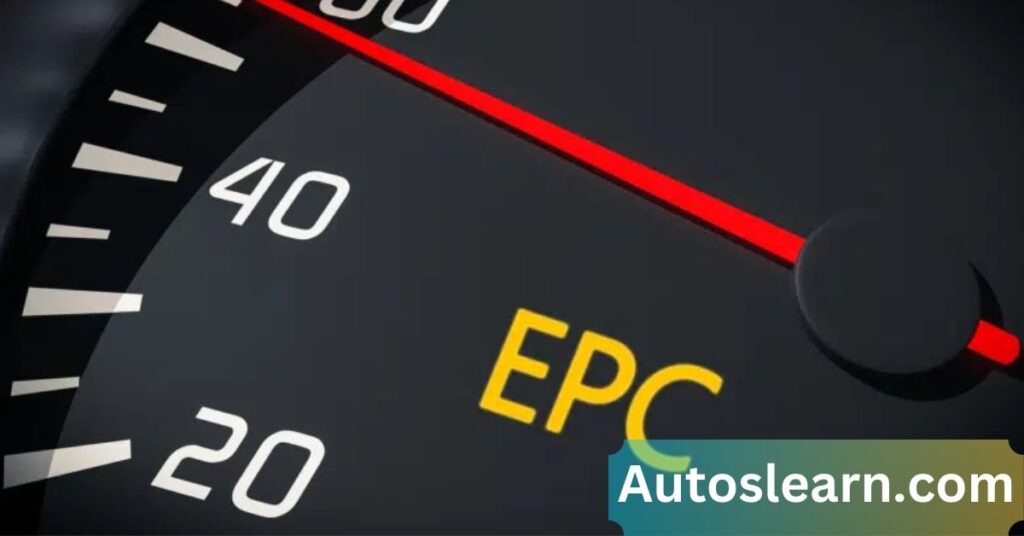
You can drive a short distance with the EPC light on, but it’s not a good long-term solution. The car may enter limp mode, which means the computer limits engine power to protect it. You might feel like the car can’t speed up very well. According to experts, it’s safest not to continue driving when the EPC light is on.
1. Reduced Power:
The car might only let you go up to a certain speed or in a specific gear. This is done to prevent engine damage. For example, the Michanic guide explains that the vehicle may enter limp mode when EPC is on, which limits power.
2. Safety Risk:
If the throttle or brake signals are wrong, the car may not accelerate or brake as expected. This is why experts warn against driving with the EPC light. It can create a dangerous situation, especially in traffic or on highways.
3. Risk of Damage:
Neglecting the EPC warning may turn a minor issue into a major one. Something minor that caused the light (like a dirty sensor) could lead to engine misfires or poor fuel economy if left unchecked.
What to do: If the EPC light comes on, slow down and head to a safe place. If the car feels too weak or unsafe, call for help. If you must drive, go slowly and carefully to a mechanic or home. Please turn off the cruise control, as it depends on the throttle system, which could be experiencing issues.
Bottom line: Avoid driving with the EPC light on more than needed. Use it only to get safely off the road or to a repair shop. It’s better to be cautious and have the car checked than risk an accident or more damage.
Checking the EPC Code with an OBD-II Scanner:
One of the best ways to diagnose an EPC light issue is to use an OBD-II scanner. Most cars made after 1996 (including Audis) have this port. Here’s how to use it in plain language:
- Locate the OBD-II Port: It is usually under the dashboard near the steering wheel. It might be a trapezoid-shaped socket.
- Plug in the Scanner: Use any OBD-II code reader or scanner tool. Plug it into the port with the key off.
- Turn on the Ignition: Turn your car’s ignition to the “on” setting—usually, (there’s no need to start the engine).
- Read Codes: Follow the scanner instructions to read the fault codes. The scanner will show codes like P0120 or something corresponding to specific problems.
- Interpret the Codes: The codes tell you what part of the engine management system reported a fault. For example, P0121 might mean “Throttle Position Sensor out of range.” Use the scanner’s manual or an online resource to understand these codes.
- Clear Codes (Optional): Many scanners allow you to clear codes. This can reset the EPC light if the problem is fixed, but remember, the light may return if the issue is not fixed.
Using a scanner is much better than guessing. The Audi experts at BW Performance explain that a diagnostic scanner will provide error codes that pinpoint what needs attention. Even if you plan to take the car to a mechanic, knowing the code can save time and money by identifying the likely culprits ahead of time.
You can even use smartphone adapters and an app for simple code readers. Just make sure the reader you choose can read generic and manufacturer-specific codes for Audi (some cheap readers only read basic codes).
Resetting the EPC Light Yourself:
Sometimes, the EPC light turns on accidentally or due to a minor glitch. In such cases, you can reset (turn off) the light yourself. However, this should be done only if you are sure there is no genuine issue. Resetting a light without fixing the problem can cause the code to return later.
How to reset the EPC light:
- Disconnect the Battery: A straightforward way is to disconnect the car battery. Leave it off for a few minutes and reconnect. This can clear many error codes. (Make sure you have your radio code or any needed settings, as they may reset, too.)
- Use a Scanner: Many OBD-II tools have a “clear codes” function. After fixing the issue, or if you think it was a false alarm, use the scanner to erase the EPC code. The BW Performance guide notes that a scanner can reset the EPC light.
- Turn the Ignition: In some older Audis, you might try turning the key on and off a few times. However, this method is unreliable compared to the methods above.
When to reset: Only do this if you know what caused the light and have fixed it, such as if you cleaned the throttle body or replaced a bad sensor. The Audi La Crosse dealership article warns that you should reset only when no maintenance issue is left. If you clear the light without fixing the cause, the car’s computer will likely notice the problem again and turn the light back on, sometimes within a few drives.
When to Seek Professional Service about EPC Light:
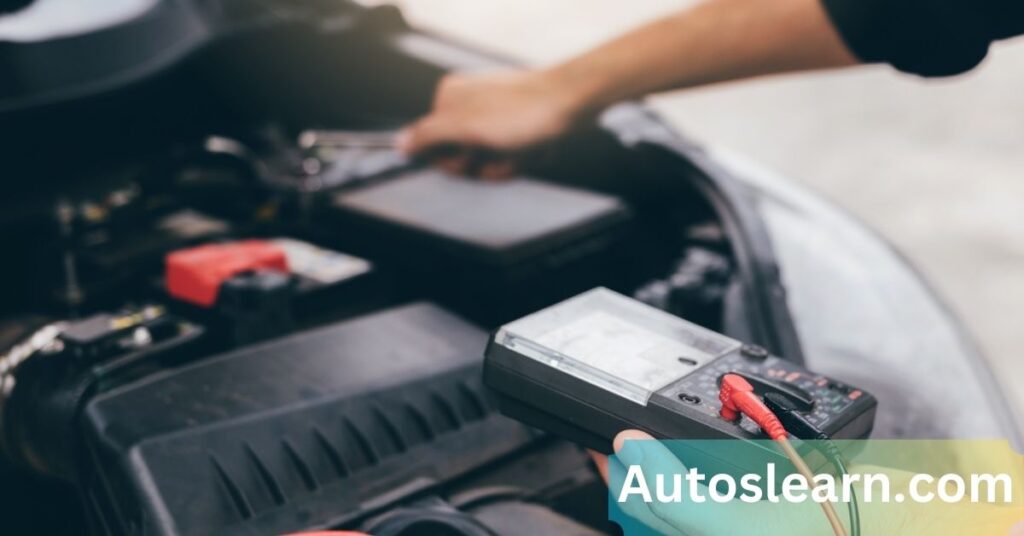
While some people might attempt minor fixes themselves, there are times when you should get a professional mechanic involved:
- Persistent Light: If the EPC light stays on after restarting the car or clearing codes, professional help is needed. It means the underlying fault is still there.
- Limp Mode: If the car repeatedly goes into limp mode with little power, do not try to drive long distances. Get it towed to a shop.
- Multiple Lights: If the EPC light comes on with other warning lights (like the engine or brake lights), this indicates more complex issues.
- Brake System Concerns: If your brake lights are not working or the car won’t let you shift out of the park, a mechanic should safely fix the brake light switch or brake ECU.
- No Code Reader: If you can’t access a scanner, a shop can read and interpret the codes. Modern Audis needs precise diagnostic equipment.
- Safety First: Any issues involving throttle control or engine misfires should be handled by an experienced technician since they directly affect how safely the car can be driven.
In summary, get help if the problem is not apparent and fixed quickly. An early professional diagnosis can prevent a minor fix from becoming a costly repair. Many mechanics have specialized tools and knowledge of Audi systems, which can save you time. The Mechanic guide suggests that prompt, professional attention to the EPC light can prevent more serious problems.
Frequently Asked Questions:
Q1. What exactly does “EPC” stand for on my Audi dash?
It stands for Electronic Power Control. This system monitors engine acceleration parts, like the throttle and sensors, to ensure your car runs properly.
Q2. Is the EPC light the same as the Check Engine Light?
No, they are different. The Check Engine Light covers many engine faults (like fuel system or emissions), while the EPC light is specifically about the electronic throttle control and related systems. However, some sensor failures might trigger both lights.
Q3. Can I drive to work if the EPC light comes on?
You may be able to drive a short distance cautiously, but it is safer not to. Driving with the EPC light on can trigger limp mode or reduce power. Only drive slowly to a safe place or directly to a mechanic, and avoid highway speeds if possible.
Q4. What if the EPC light turns off by itself?
Sometimes, the light may go off if a sensor glitch clears or the car is restarted. However, if the underlying issue remains, the light will return. It’s wise to check the vehicle even if the light goes off.
Q5. How much does it cost to fix the EPC light?
The cost depends on the cause. If it’s something simple like cleaning the throttle body, it could be cheap or even DIY. Replacing a sensor or switch might cost a few hundred dollars. Worse, if the ECU needs repair, it can be expensive. Always start with a diagnostic scan to determine the exact cause before guessing.
Q6. How is resetting the EPC light okay?
You should reset only if you have fixed the problem, such as after cleaning a dirty throttle body or replacing a bad sensor. If you just clear the code without a fix, the light will probably come back. Audi experts say you should only reset the light when you are sure no maintenance is needed.
Conclusion:
The EPC light on your Audi is an important warning that should never be ignored. It signals that something is wrong with the car’s electronic engine or throttle control system — often related to sensors, the throttle body, or braking and acceleration components.
While the car may still drive in a limited way, ignoring the light can lead to poor performance, reduced fuel efficiency, or even more serious damage.
Whether a simple issue like a faulty sensor or something more complex, using an OBD-II scanner and addressing the problem early can save time, money, and stress; if you’re unsure about the cause, it’s always best to consult a qualified mechanic to keep your Audi running safely and reliably.

